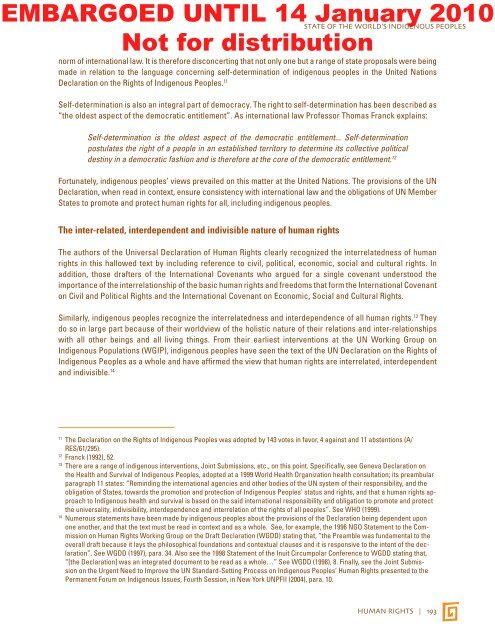STATE OF THE WORLD's INDIGENOUs PEOpLEs - CINU
STATE OF THE WORLD's INDIGENOUs PEOpLEs - CINU
STATE OF THE WORLD's INDIGENOUs PEOpLEs - CINU
- No tags were found...
You also want an ePaper? Increase the reach of your titles
YUMPU automatically turns print PDFs into web optimized ePapers that Google loves.
EMBARGOED UNTIL 14 January 2010<strong>STATE</strong> <strong>OF</strong> <strong>THE</strong> WORLD’S INDIGENOUS PEOPLESNot for distributionnorm of international law. It is therefore disconcerting that not only one but a range of state proposals were beingmade in relation to the language concerning self-determination of indigenous peoples in the United NationsDeclaration on the Rights of Indigenous Peoples. 11Self-determination is also an integral part of democracy. The right to self-determination has been described as“the oldest aspect of the democratic entitlement”. As international law Professor Thomas Franck explains:Self-determination is the oldest aspect of the democratic entitlement... Self-determinationpostulates the right of a people in an established territory to determine its collective politicaldestiny in a democratic fashion and is therefore at the core of the democratic entitlement. 12Fortunately, indigenous peoples’ views prevailed on this matter at the United Nations. The provisions of the UNDeclaration, when read in context, ensure consistency with international law and the obligations of UN MemberStates to promote and protect human rights for all, including indigenous peoples.The inter-related, interdependent and indivisible nature of human rightsThe authors of the Universal Declaration of Human Rights clearly recognized the interrelatedness of humanrights in this hallowed text by including reference to civil, political, economic, social and cultural rights. Inaddition, those drafters of the International Covenants who argued for a single covenant understood theimportance of the interrelationship of the basic human rights and freedoms that form the International Covenanton Civil and Political Rights and the International Covenant on Economic, Social and Cultural Rights.Similarly, indigenous peoples recognize the interrelatedness and interdependence of all human rights. 13 Theydo so in large part because of their worldview of the holistic nature of their relations and inter-relationshipswith all other beings and all living things. From their earliest interventions at the UN Working Group onIndigenous Populations (WGIP), indigenous peoples have seen the text of the UN Declaration on the Rights ofIndigenous Peoples as a whole and have affirmed the view that human rights are interrelated, interdependentand indivisible. 1411The Declaration on the Rights of Indigenous Peoples was adopted by 143 votes in favor, 4 against and 11 abstentions (A/RES/61/295).12Franck (1992), 52.13There are a range of indigenous interventions, Joint Submissions, etc., on this point. Specifically, see Geneva Declaration onthe Health and Survival of Indigenous Peoples, adopted at a 1999 World Health Organization health consultation; its preambularparagraph 11 states: “Reminding the international agencies and other bodies of the UN system of their responsibility, and theobligation of States, towards the promotion and protection of Indigenous Peoples' status and rights, and that a human rights approachto Indigenous health and survival is based on the said international responsibility and obligation to promote and protectthe universality, indivisibility, interdependence and interrelation of the rights of all peoples”. See WHO (1999).14Numerous statements have been made by indigenous peoples about the provisions of the Declaration being dependent uponone another, and that the text must be read in context and as a whole. See, for example, the 1996 NGO Statement to the Commissionon Human Rights Working Group on the Draft Declaration (WGDD) stating that, “the Preamble was fundamental to theoverall draft because it lays the philosophical foundations and contextual clauses and it is responsive to the intent of the declaration”.See WGDD (1997), para. 34. Also see the 1998 Statement of the Inuit Circumpolar Conference to WGDD stating that,“[the Declaration] was an integrated document to be read as a whole…” See WGDD (1998), 8. Finally, see the Joint Submissionon the Urgent Need to Improve the UN Standard-Setting Process on Indigenous Peoples’ Human Rights presented to thePermanent Forum on Indigenous Issues, Fourth Session, in New York UNPFII (2004), para. 10.HUMAN RIGHTS | 193
















